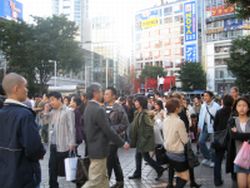Population of Japan

According to the Official Japan Statistics Bureau, the total population of Japan as of December 2007 was 127,790,000. This ranks it 10th in the world, placing it right behind Russia and just ahead of Mexico.
The population density of Japan is 343 persons per square kilometer, ranking it fifth among countries with a population of at least 10 million. As a comparison, India ranked 4th and Belgium 6th.
As you might expect, Tokyo is Japan’s most populated city, with a population of about 8.6 million residing in the 23 wards of Tokyo, followed by Yokohama (3.6 million), Osaka (2.6 million), and Nagoya (2.2 million).
Japan’s population is highly concentrated in urban areas. In fact, as of 2000, just over 44% of Japan’s population was concentrated within the Tokyo, Osaka, and Nagoya metropolitan areas.
![]()
Japan’s Declining Birth Rate and Aging Population
Japan has a declining birth rate and aging population. As of 2006, over 20% (26.60 million) of Japan’s population was aged 65 or older.
In contrast, Japan’s younger population (0-14) has been shrinking. In 2006, only 13.6% (17.44 million) of the overall population fell within this age category.
Likewise, the birth rate in Japan has declined dramatically over the past few decades. Between 1971 and 1973, Japan’s birth rate averaged 19 births per 1,000 population. By 2006, this number had dropped all the way down to 8.7..
Due to these trends, as a proportion of the total population of Japan, the elderly population has been more numerous than the younger population since 1997. This aging of Japan’s society is a source of great concern among Japanese, and will have significant implications on Japan’s society and economy in the coming decades.
![]()
Life Expectancy in Japan
Life expectancy in Japan is among the highest in the world. In 2006, life expectancy at birth for women was 85.81 years and 79.00 years for men. Japan ranks third in the world in overall life expectancy, at 82.02 years.
![]()
